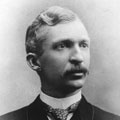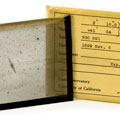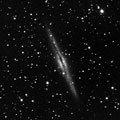

 Detail of Keeler's 1899 photograph of the "spiral nebula" M51.
James E. Keeler was another member of the original Lick staff who, like Barnard, made important
contributions as both a visual and photographic observer. In his first years at Lick, he did
groundbreaking work using a visual spectroscope of his own design on the 36-inch refractor
to analyse the light of unusual stars and glowing nebulae.
Keeler left Lick in 1891 to
become director of the Allegheny Observatory in Pittsburgh, returning seven years later as Lick's
second director. While at Allegheny he had taught himself photography, and on his return to
Mount Hamilton began making exposures with the observatory's newly
acquired 36-inch Crossley reflector.
Keeler was drawn to the spiral nebulae, as they were then called, and the Crossley was well suited
to recording them photographically. To bring out their faint features he took many long
exposures of these then poorly understood objects. To Keeler's surprise, his plates revealed many
fainter and presumably more distant spirals in the background. This was an enormously important
discovery, showing that what we now know to be galaxies—vast, remote star
systems like our Milky Way—are numerous and a major constituent of the universe. Keeler had
pushed deeper into space than ever before. A more convincing demonstration of photography's
power for astronomy could hardly be imagined. Sadly, Keeler's highly promising career was cut
short in 1900 by his untimely death at the age of forty-two.
Detail of Keeler's 1899 photograph of the "spiral nebula" M51.
James E. Keeler was another member of the original Lick staff who, like Barnard, made important
contributions as both a visual and photographic observer. In his first years at Lick, he did
groundbreaking work using a visual spectroscope of his own design on the 36-inch refractor
to analyse the light of unusual stars and glowing nebulae.
Keeler left Lick in 1891 to
become director of the Allegheny Observatory in Pittsburgh, returning seven years later as Lick's
second director. While at Allegheny he had taught himself photography, and on his return to
Mount Hamilton began making exposures with the observatory's newly
acquired 36-inch Crossley reflector.
Keeler was drawn to the spiral nebulae, as they were then called, and the Crossley was well suited
to recording them photographically. To bring out their faint features he took many long
exposures of these then poorly understood objects. To Keeler's surprise, his plates revealed many
fainter and presumably more distant spirals in the background. This was an enormously important
discovery, showing that what we now know to be galaxies—vast, remote star
systems like our Milky Way—are numerous and a major constituent of the universe. Keeler had
pushed deeper into space than ever before. A more convincing demonstration of photography's
power for astronomy could hardly be imagined. Sadly, Keeler's highly promising career was cut
short in 1900 by his untimely death at the age of forty-two.
Click on the thumbnails below for more on the work of James E. Keeler.
 James E. Keeler
James E. Keeler
 Photographic plate
Photographic plate
 NGC 891, 1899
NGC 891, 1899
